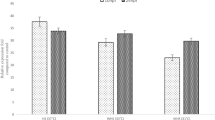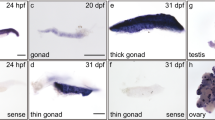Abstract
Nucleotide excision repair (NER) removes helix-distorting DNA lesions such as UV-induced pyrimidine dimers and cisplatin-induced strand crosslinking. Our earlier studies have identified low-molecular-weight proteins homologous to the 150-kDa vitellogenin 1 (Vg1) as UV-damaged DNA-binding factors expressed in developing zebrafish (Danio rerio). This present study explored if Vg1-like proteins also participated in NER in zebrafish. Immunoblot analysis of affinity-captured 12 h post-fertilization (hpf) zebrafish extract proteins showed a transient binding of a 30-kDa Vg1-like polypeptide to UV-damaged DNA. A transcription-based in vitro repair assay revealed a significant up-regulation of UVC or cisplatin-suppressed transcriptional activity of a marker cDNA driven by a SP6 RNA polymerase-regulated promotor after incubating the damaged plasmid with the extracts of 12 hpf embryos or 96 hpf larvae. The up-regulation of UV or cisplatin-suppressed transcription was abolished in the presence of a monoclonal anti-zebrafish Vg1 antibody. The differential sensitivity of UV-induced repair in 12 and 96 hpf zebrafish extracts to exogenous ATP suggested a development-dependent expression of Vg1-like NER factors. A T4 endonuclease V digestion assay showed no inhibition of the anti-Vg1 antibody on the excision of UV-induced cyclobutane pyrimidine dimers. Our results identified the participation of Vg1-like factors in NER in developing zebrafish, and these factors may function at post-incison steps of NER.





Similar content being viewed by others
References
Amacher SL (2008) Emerging gene knockout technology in zebrafish: zinc-finger nucleases. Brief Funct Genomic Proteomic 7:460–464
Boyce RP, Howard-Flanders P (1964) Release of ultraviolet light-induced thymine dimers from DNA in E. coli K-12. Proc Natl Acad Sci 51:293–300
Cleaver JE (1968) Defective repair replication of DNA in xeroderma pigmentosum. Nature 218:652–656
De Weerd-Kastelein EA, Keijzer W, Bootsma D (1972) Genetic heterogeneity of xeroderma pigmentosum demonstrated by somatic cell hybridization. Nat New Biol 238:80–83
DiGiovanna JJ, Kraemer KH (2012) Shining a light on xeroderma pigmentosum. J Invest Dermato 132:785–796
Dong Q, Svoboda K, Tiersch TR, Monroe WT (2007) Photobiological effects of UVA and UVB light in zebrafish embryos: evidence for a competent photorepair system. J Photochem Photobiol B 88:137–146
Falchuk KH, Montorzi M (2001) Zinc physiology and biochemistry in oocytes and embryos. Biometals 14:385–395
Fortier S, Yang X, Wang Y, Bennett RA, Strauss PR (2009) Base excision repair in early zebrafish development: evidence for DNA polymerase switching and standby AP endonuclease activity. Biochemistry 48:5396–5404
Gillet LC, Schärer OD (2006) Molecular mechanisms of mammalian global genome nucleotide excision repair. Chem Rev 106:253–276
Groche D, Bashkovetsky LG, Falchuk KH, Auld DS (2000) Subunit composition of the zinc proteins α and β-lipovitellin from chicken. J Protein Chem 19:379–387
Guo C, Tang T-S, Friedberg EC (2010) SnapShot: nucleotide excision repair. Cell 140:754
Hanawalt PC, Spivak G (2008) Transcription-coupled DNA repair: two decades of progress and surprises. Nat Rev Mol Cell Biol 9:958–970
Hsu T, Cheng CS, Shih CY, Yeh FL (2002) Detection and partial characterization of a UV-damaged-DNA binding activity highly expressed in zebrafish (Danio rerio) embryos. Fish Physiol Biochem 25:41–51
Kang TH, Peardon JT, Sancar A (2011) Regulation of nucleotide excision repair activity by transcriptional and posttranscriptional control of the XPA protein. Nucl Acids Res 39:3176–3187
Kimmel CB, Ballard WW, Kimmel SR, Ullmann B, Schilling TF (1995) Stages of embryonic development of the zebrafish. Dev Dyn 203:253–310
Koberle B, Grimaldi KA, Sunters A, Hartley JA, Kelland LR, Masters JRW (1997) DNA repair capacity and cisplatin sensitivity of human testis tumour cells. Int J Cancer 70:551–555
Lai YS, Chiue LF, Hsu T (2006) Low-molecular-weight vitellogenin 1-like proteins are components of a UV-damaged-DNA binding activity highly expressed in zebrafish (Danio rerio) embryos. J Exp Zool A 305:215–224
Lai YS, Hsieh FJ, Hsu T (2012) Affinity isolation and mass spectral analysis of 1,10-phenanthroline (OP)-stimulated UV-damaged-DNA binding proteins expressed in zebrafish (Danio rerio) embryos. Fish Physiol Biochem 38:1117–1129
Langheinrich U, Hennen E, Stott G, Vacun G (2002) Zebrafish as a model organism for the identification and characterization of drugs and genes affecting p53 signaling. Curr Biol 12:2023–2028
Mathieu N, Kaczmarek N, Ruthemann P, Luch A, Naegeli H (2013) DNA quality control by a lesion sensor pocket of the xeroderma pigmentosum group D helicase subunit of TFIIH. Curr Biol 23:204–212
Meng X, Bartholomew C, Craft JA (2010) Differential expression of vitellogenin and oestrogen receptor genes in the liver of zebrafish, Danio rerio. Anal Bioanal Chem 396:625–630
Montorzi M, Falchuk KH, Vallee BL (1995) Vitellogenin and lipovitellin: zinc proteins of Xenopus laevis oocytes. Biochemistry 34:10851–10858
Nishi R, Alekseev S, Dinant C, Hoogstraten D, Houtsmuller AB, Hoeijmakers JH, Vermeulen W, Hanaoka F, Sugasawa K (2009) UV-DDB-dependent regulation of nucleotide excision repair kinetics in living cells. DNA Repair 8:767–776
Notch EG, Miniutti DM, Mayer GD (2007) 17 alpha-Ethinylestradiol decreases expression of multiple hepatic nucleotide excision repair genes in zebrafish (Danio rerio). Aquat Toxicol 84:301–309
Nouspikei T (2009) DNA repair in mammalian cells: nucleotide excision repair: variations on versatility. Cell Mol Life Sci 66:994–1009
Pasheva E, Pasheva I, Favre A (1998) Preferential binding of high mobility group 1 protein to UV-damaged DNA: role of the COOH-terminal domain. J Biol Chem 273:24730–24736
Pei DS, Strauss PR (2013) Zebrafish as a model system to study DNA damage and repair. Mutat Res 743-744:151–159
Qiao Y, Spitz MR, Guo Z, Hadeyati M, Grossman L, Kraemer KH, Wei Q (2002) Rapid assessment of repair of ultraviolet DNA damage with a modified host-cell reactivation assay using a luciferase reporter gene and correlations with polymorphisms of DNA repair genes in normal human lymphocytes. Mutat Res 509:165–174
Radany EH, Friedberg EC (1980) A pyrimidine dimer-DNA glycosylase activity associated with the v gene of bacteriophage T4. Nature 286:182–185
Schwerdtle T, Walter I, Hartwig A (2003) Arsenite and its biomethylated metabolites interfere with the formation and repair of stable BPDE-induced DNA adducts in human cells and impair XPAzf and Fpg. DNA Repair 2:1449–1463
Silva IA, Cancela ML, Conceicao N (2012) Molecular cloning and expression analysis of xpd from zebrafish (Danio rerio). Mol Biol Rep 39:5339–5348
Sugasawa K, Masutani C, Hanaoka F (1993) Cell-free repair of UV-damaged simian virus 40 chromosomes in human cell extracts I. Development of a cell-free system detecting excision repair of UV-irradiated SV 40 chromosomes. J Biol Chem 268:9098–9104
Sugasawa K, Okamoto T, Shimizu Y, Masutani C, Twai S, Hanaoka F (2001) A multistep damage recognition mechanism for global genomic nucleotide excision repair. Genes Dev 15:507–521
Sugasawa K, Okuda Y, Saijo M, Nishi R, Matsuda N, Chu G, Mori T, Iwai S, Tanaka K, Hanaoka F (2005) UV-induced ubiquitylation of XPC protein mediated by UV-DDB-ubiquitin ligase complex. Cell 121:387–400
Sussman R (2007) DNA repair capacity of zebrafish. Proc Natl Acad Sci 104:13379–13383
Tanaka K, Miura N, Setokara I, Miyamoto I, Yoshida MC, Satoh Y, Kondo S, Yasui A, Okayama H, Okada Y (1990) Analysis of a human DNA excision repair gene involved in group A xeroderma pigmentosum and containing a zinc-finger domain. Nature 348:73–76
Tang J, Chu G (2002) Xeroderma pigmentosum complementation group E and UV-damaged DNA-binding protein. DNA Repair 1:601–616
Tong Y, Shan T, Poh YK, Yan T, Wang H, Lam SH, Gong Z (2004) Molecular cloning of zebrafish and medaka vitellogenin genes and comparison of their expression in response to 17beta-estradiol. Gene 328:25–36
Vichi P, Coin F, Renaud JP, Vermeulen W, Hoeijmakers JHJ, Moras D (1997) Cisplatin and UV-damaged DNA lure the basal transcription factor TFIID/TBP. EMBO J 16:7444–7456
Wang H, Yan T, Tan JTT, Gong Z (2000) A zebrafish vitellogenin gene (vg3) encodes a novel vitellogenin without a phosvitin domain and may represent a primitive vertebrate vitellogenin gene. Gene 256:303–310
Wang H, Tan JT, Emelyanov A, Korzh V, Gong Z (2005) Hepatic and extrahepatic expression of vitellogenin genes in the zebrafish, Danio rerio. Gene 356:91–100
Yeh F-L, Yan H-L, Wang S-Y, Jung T-Y, Hsu T (2003) Molecular cloning of zebrafish (Danio rerio) MutS homolog 6 (MSH6) and noncoordinate expression of MSH6 gene activity and G-T mismatch binding proteins in zebrafish larvae. J Exp Zool A 297:118–129
Zeng Z, Richardson J, Verduzco D, Mitchell DL, Patton EE (2006) Zebrafish have a competent p53-dependent nucleotide excision repair pathways to resolve ultraviolet B-induced DNA damage in the skin. Zebrafish 6:405–415
Acknowledgements
This work was financially supported by the Ministry of Science and Technology of Taiwan, Republic of China, under grant numbers NSC 100-2313-B-019-009 and NSC 102-2313-B-019-017.
Author information
Authors and Affiliations
Corresponding author
Electronic supplementary material
Suppl. Fig.1.
Detection of T4 endonuclease V-mediated incision of UV-irradiated TT probe carrying a CPD by denaturing PAGE. Biotin-labelled duplex TT probe (4 pmole) was irradiated with UV at 9 kJ m-2 to generate a CPD between two adjacent TT bases on one strand according to a previous report (Pasheva et al. 1998). To confirm the production of CPD, UV-irradiated or unirradiated TT probe was incubated at 37 °C for 16 h with CPD-specific T4 endonuclease V(1 unit). The reaction mixture was electrophoresed on a 6% denaturing polyacrylamide gel and blotted overnight onto a nylon membrane. The presence of a biotin-labelled 5’ short single strand fragment (see arrow) due to enzyme-mediated incision and strand cleavage was detected by incubating the membrane with streptavidin-conjugated alkaline phosphatase and chemilluminesent enzyme substrates. (PPTX 124 kb)
Rights and permissions
About this article
Cite this article
Shen, YC., Hsu, T., Ling, LB. et al. Identification of low-molecular-weight vitellogenin 1 (Vg1)-like proteins as nucleotide excision repair (NER) factors in developing zebrafish (Danio rerio) using a transcription-based DNA repair assay. Fish Physiol Biochem 43, 663–676 (2017). https://doi.org/10.1007/s10695-016-0321-4
Received:
Accepted:
Published:
Issue Date:
DOI: https://doi.org/10.1007/s10695-016-0321-4




